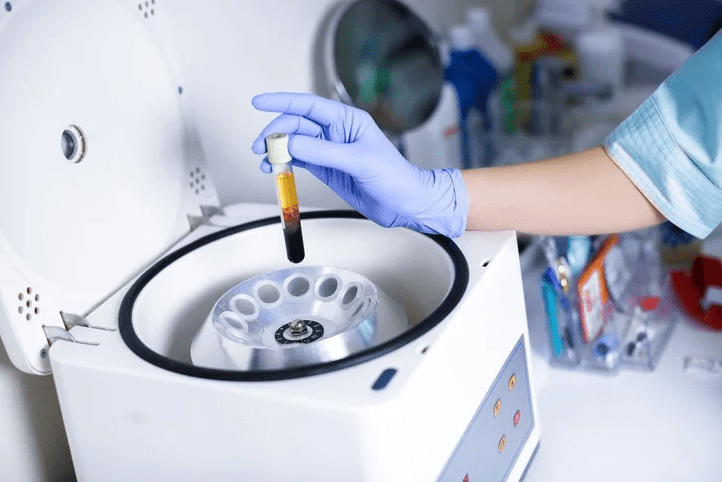The force of gravity will cause sedimentation of particles from a heterogeneous mixture; larger and denser particles sedimentfaster than the smaller and less dense particles. This phenomenon is useful for separating heterogeneous solutions into independent components, and for the isolation and enrichment of target molecules, cells, and cell organelles. Differential centrifugation accelerates the separation process by introducing centripetal forces many times greater than gravity. The precipitated particles form a pellet at the bottom of the tube during centrifugation. The rate of sedimentation is dependent on the size and density of the particles, so centrifugation can be used to isolate target particles simply by controlling centrifugal force or the rate of centrifugation. The rate of centrifugation is reported as angular velocity by revolutions per minute (rpm) or as acceleration(g). RPM is dependent on the radius of the rotor in the centrifuge.
Differential centrifugation vs density gradient centrifugation
There are two main methods of separating particles by centrifugation: differential centrifugation and density gradient centrifugation. Differential centrifugation capitalizes upon the differential rates of sedimentation of particles of varying density. The larger, denser particles have a higher rate of sedimentation. Density gradient centrifugation produces a cleaner separation of particles than differential centrifugation by employing a density matrix for the particles to move through.
The differential centrifugation process involves multiple centrifugation steps of incrementally increased centrifugal force. The largest and densest particles with the greatest rate of sedimentation will comprise the pellet during the initial low-force spin while the smaller, less dense particles remain in the supernatant. The pellet and supernatant can then be separated, and the supernatant can be placed back into the centrifuge at a higher centrifugal force to pull out the next group of particles with a lower rate of sedimentation. This process is repeated as many times as necessary to isolate each desired group of particles. As an example, cells that are lysed in a detergent-free buffer and all membrane-bound proteins will remain associated with their specific membranes. After centrifugation the soluble cytosolic proteins will be located in the supernatant while the membrane associated proteins will be in the heavier pellet. To further enrich proteins from a specific cellular organelle, differential centrifugation can be used. Nuclei will form a pellet when centrifuged at 600 g for 10 minutes. The supernatant can be further centrifuged at 15,000 g for 10 minutes to bring mitochondria and lysosomes into the pellet, while the supernatant from this step can be centrifuged again at 100,000 g for 10 minutes to collect a microsomal pellet. The heterogeneity of biological particles makes isolates from differential centrifugation prone to contamination and poor recovery. This issue can be fixed by washing the pellet and repeating the centrifugation protocol, and by further filtering the sample.
Density gradient centrifugation employs a tube packed with a material that forms a gradient of increasing density and viscosity. Various types of media are used for density gradient separation including polyhydric alcohols, polysaccharides, inorganic salts, and silica. The type of matrix used is chosen based on the target molecule. The density gradient matrix allows for more stringent separation of particles with less contamination. The particles move through the matrix at different sedimentation rates and settle out into clean bands.
Rate-Zonal and Isopycnic Centrifugation
Density gradient centrifugation can be further broken up into two categories, Rate-Zonal and Isopycnic. The gradient in isopycnic centrifugation is continuous while the gradient in rate-zonal goes in steps, or “zones.” A rate-zonal centrifugation begins with several solutions of varying densities or viscosities, particles of interest are adding to this. As centrifugation takes place, molecules are separated based on their size with smaller molecules remaining at the top, unable to penetrate the higher viscosity layers. For the continuous layer formed in isopycnic centrifugation, molecules can be separated by their density as they migrate to a place within the gradient that matches their density.
Consideration of osmolality and typically used gradient medium
The process of creating a gradient may naturally bring your sample into drastic environments. Your sample may contain cellular components, organelles, or nucleic acid, or proteins, all of which can be altered by osmolality. For example, there is a body of research that suggests that DNA takes a different form based on the concentration of water surrounding it, which can cause different migration within a centrifugation protocol depending on how water can surround it. There are media that are typically used for the mentioned centrifugation methods. Organelles may be separated by colloidal silica or iodinated media. DNA and RNA can be separated by organic sals.
Determining the ideal medium for your density gradient
There are several factors that play a role in determining the best medium for your centrifugation method. First you want to make sure that the medium you choose will not interfere with your sample, for example, a medium that will not harm cellular components. You want it to be autoclavable, as with many solutions you use for your important samples. You need to consider the ionic nature and strength of the medium so that it does not stress the charge and stability of your sample. The medium must have the capacity to form the range of densities or viscocities you are interested in, or the gradient will be impossible. Ideally, the medium will also be low cost, but you rarely find all these factors perfectly as you want them so you must balance the factors most important to your sample and consider its stability.
Biomagnetic separation and centrifugation
Centrifugation and filtration are both important steps in bio separation protocols. Biomagnetic separation can speed up the process by quickly binding and isolating targets from a heterogeneous solution (positive selection) or by binding and washing out contaminants (negative selection). A combination of differential centrifugation and biomagnetic separation is used in many isolation protocols to achieve a highly enriched target population. Biomagnetic separation can often even eliminate the need for centrifugation steps, allowing for highly efficient separation.
Related news
- Enzymes in industry
- Filtration system
- Making process validation easier with a modern biomagnetic separation rack





